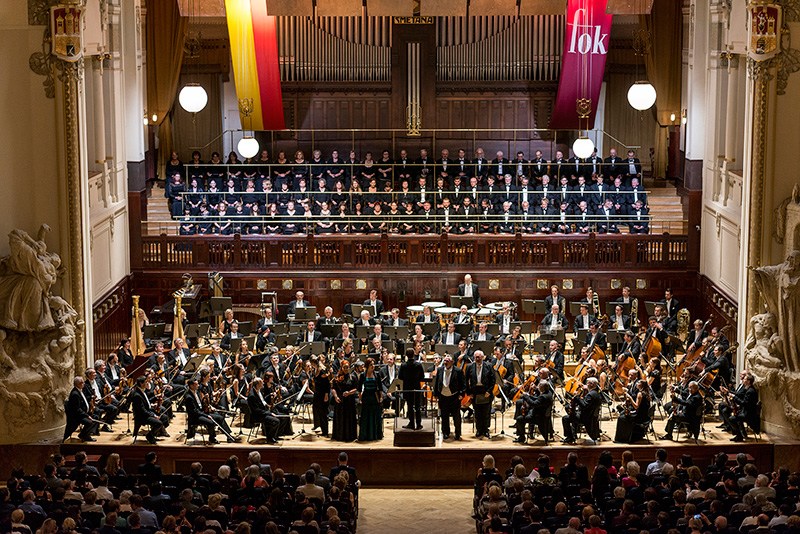Pavlů, Prague SO, Inkinen, Cadogan Hall review - exhilarating but uneven Mahler Third | reviews, news & interviews
Pavlů, Prague SO, Inkinen, Cadogan Hall review - exhilarating but uneven Mahler Third
Pavlů, Prague SO, Inkinen, Cadogan Hall review - exhilarating but uneven Mahler Third
Czech band brings excitement and colour, but their dizzy climaxes overwhelm

The Prague Symphony Orchestra are in town, their Cadogan Hall concert the London leg of a UK tour. It’s ambitious, including Mahler’s epic Third Symphony in five different cities, each with a local chorus. The orchestra itself, Prague’s second band, is a spirited and distinctively Central European ensemble.
Cadogan Hall isn’t ideal for such a huge orchestra, and the players sprawled out under the side balconies and well into the auditorium on temporary stage extensions. The two choirs, the Tiffin Boys’ Choir and the ladies of the Brighton Festival Chorus, were positioned in the balconies above, and everything was a squeeze. Acoustically, it just about worked, although there was nowhere to hide in the quietest passages, which lacked mystery when we could hear every bow stroke, and the climaxes often overwhelmed – and not in a good way (pictured below: the Prague Symphony Orchestra in its much more spacious home in Prague, the Smetana Hall).  Inkinen is a dynamic conductor, and his tempos rarely stay fixed for long. That made the first movement seem choppy and episodic – which it is, although other conductors make efforts to hide the fact. Some distinctive woodwind and brass playing brought Czech flavour. The narrow-bore trumpets sang out their fanfares, with just a hint of vibrato. The trombone solo, from Jiří Novotný, was suitably brassy, if a little angular. Strangest of all was the principal horn, who sported a bandana and writhed uneasily in her seat. Her solos were excellent, but she treated every small grouping as if she was in charge, applying rubato and dynamic swells as she saw fit. I wonder what the rest of the orchestra makes of her.
Inkinen is a dynamic conductor, and his tempos rarely stay fixed for long. That made the first movement seem choppy and episodic – which it is, although other conductors make efforts to hide the fact. Some distinctive woodwind and brass playing brought Czech flavour. The narrow-bore trumpets sang out their fanfares, with just a hint of vibrato. The trombone solo, from Jiří Novotný, was suitably brassy, if a little angular. Strangest of all was the principal horn, who sported a bandana and writhed uneasily in her seat. Her solos were excellent, but she treated every small grouping as if she was in charge, applying rubato and dynamic swells as she saw fit. I wonder what the rest of the orchestra makes of her.
The string sound was rich but sometimes lacked security. That was a shame, because one of Inkinen’s great strengths is creating magical moments out of quiet episodes or mood changes. So when Mahler cuts off the orchestra and introduces a new theme in the cellos and basses, for example, Inkinen makes a real feature of it, but the players don’t quite give him the precision he needs to pull it off.
Inkinen began the second movement in a stately fashion – a dance, though hardly a rustic one – but soon raised the temperature, with a series of huge, kaleidoscopic climaxes, the tempos fast and variable, an exhilarating but often disorientating effect. The third movement coped better with Inkinen’s adrenaline-fuelled drive, the tuttis here clothed in more elaborate orchestral effects. And he held everything back beautifully for the off-stage post horn, beautifully played (on a trumpet) by Marek Zvolánek.
 Mezzo Ester Pavlů (pictured left) was a welcome new arrival on the London stage for her fourth movement solo, the eerie setting of Nietzsche’s “Midnight Song”. Her voice projects effortlessly, and her German diction is excellent, but her tone was a little lacking in character and colour, especially in the top register. Inkinen, too, struggled to make this movement evocative or atmospheric, a surprise given how often he achieved similar effects in the earlier ones. The choirs both sang well in the fifth movement, although facing the orchestra rather than the audience diminished their volume.
Mezzo Ester Pavlů (pictured left) was a welcome new arrival on the London stage for her fourth movement solo, the eerie setting of Nietzsche’s “Midnight Song”. Her voice projects effortlessly, and her German diction is excellent, but her tone was a little lacking in character and colour, especially in the top register. Inkinen, too, struggled to make this movement evocative or atmospheric, a surprise given how often he achieved similar effects in the earlier ones. The choirs both sang well in the fifth movement, although facing the orchestra rather than the audience diminished their volume.
One more magic moment from Inkinen, the seamless transition from the ebullient fifth movement to the serene finale, the move handled perfectly and with ideal timing. The finale itself was taken a little faster than usually, but this had the effect of shaping the long string phrases more clearly. The early climaxes were again regularly whipped up to frenzy, the conductor momentarily forgetting all about the Langsam-Ruhevoll (Slow-Tranquil) tempo marking. But the orchestra raised their game here, with some particularly elegant and controlled playing, especially from the woodwind soloists. Inkinen is clearly a versatile conductor, and Mahler’s Third gives opportunities to demonstrate all sorts of textures and moods. And, despite some overwrought climaxes early on, this last movement had many moments of depth and beauty. Inkinen made it the soul of the symphony – just as it should be.
rating
Explore topics
Share this article
Add comment
The future of Arts Journalism
You can stop theartsdesk.com closing!
We urgently need financing to survive. Our fundraising drive has thus far raised £49,000 but we need to reach £100,000 or we will be forced to close. Please contribute here: https://gofund.me/c3f6033d
And if you can forward this information to anyone who might assist, we’d be grateful.

Subscribe to theartsdesk.com
Thank you for continuing to read our work on theartsdesk.com. For unlimited access to every article in its entirety, including our archive of more than 15,000 pieces, we're asking for £5 per month or £40 per year. We feel it's a very good deal, and hope you do too.
To take a subscription now simply click here.
And if you're looking for that extra gift for a friend or family member, why not treat them to a theartsdesk.com gift subscription?
more Classical music
 Solomon, OAE, Butt, QEH review - daft Biblical whitewashing with great choruses
Even a top soprano and mezzo can’t make this Handel paean wholly convincing
Solomon, OAE, Butt, QEH review - daft Biblical whitewashing with great choruses
Even a top soprano and mezzo can’t make this Handel paean wholly convincing
 Two-Piano Gala, Kings Place review - shining constellations
London Piano Festival curators and illustrious friends entertain and enlighten
Two-Piano Gala, Kings Place review - shining constellations
London Piano Festival curators and illustrious friends entertain and enlighten
 Echo Vocal Ensemble, Latto, Union Chapel review - eclectic choral programme garlanded with dance
Beautiful singing at the heart of an imaginative and stylistically varied concert
Echo Vocal Ensemble, Latto, Union Chapel review - eclectic choral programme garlanded with dance
Beautiful singing at the heart of an imaginative and stylistically varied concert
 Scott, Irish Baroque Orchestra, Whelan, RIAM, Dublin review - towards a Mozart masterpiece
Characteristic joy and enlightenment from this team, but a valveless horn brings problems
Scott, Irish Baroque Orchestra, Whelan, RIAM, Dublin review - towards a Mozart masterpiece
Characteristic joy and enlightenment from this team, but a valveless horn brings problems
 Classical CDs: Voice flutes, flugelhorns and froth
Baroque sonatas, English orchestral music and an emotionally-charged vocal recital
Classical CDs: Voice flutes, flugelhorns and froth
Baroque sonatas, English orchestral music and an emotionally-charged vocal recital
 Kanneh-Mason, Britten Sinfonia, Shave, Milton Court - a grin and a big beaming smile
A pair of striking contemporary pieces alongside two old favourites
Kanneh-Mason, Britten Sinfonia, Shave, Milton Court - a grin and a big beaming smile
A pair of striking contemporary pieces alongside two old favourites
 theartsdesk at the New Ross Piano Festival - Finghin Collins’ musical rainbow
From revelatory Bach played with astounding maturity by a 22 year old to four-hand jazz
theartsdesk at the New Ross Piano Festival - Finghin Collins’ musical rainbow
From revelatory Bach played with astounding maturity by a 22 year old to four-hand jazz
 First Person: Manchester Camerata's Head of Artistic Planning Clara Marshall Cawley on questioning the status quo
Five days of free events with all sorts of audiences around Manchester starts tomorrow
First Person: Manchester Camerata's Head of Artistic Planning Clara Marshall Cawley on questioning the status quo
Five days of free events with all sorts of audiences around Manchester starts tomorrow
 Goldscheider, Brother Tree Sound, Kings Place review - music of hope from a young composer
Unusual combination of horn, strings and electronics makes for some intriguing listening
Goldscheider, Brother Tree Sound, Kings Place review - music of hope from a young composer
Unusual combination of horn, strings and electronics makes for some intriguing listening
 theartsdesk Q&A: composer Donghoon Shin on his new concerto for pianist Seong-Jin Cho
Classical music makes its debut at London's K-Music Festival
theartsdesk Q&A: composer Donghoon Shin on his new concerto for pianist Seong-Jin Cho
Classical music makes its debut at London's K-Music Festival

Comments
The horn solos were very old